Intel SSD 520 Review: Cherryville Brings Reliability to SandForce
by Anand Lal Shimpi on February 6, 2012 11:00 AM ESTRandom Read/Write Speed
The four corners of SSD performance are as follows: random read, random write, sequential read and sequential write speed. Random accesses are generally small in size, while sequential accesses tend to be larger and thus we have the four Iometer tests we use in all of our reviews.
Our first test writes 4KB in a completely random pattern over an 8GB space of the drive to simulate the sort of random access that you'd see on an OS drive (even this is more stressful than a normal desktop user would see). I perform three concurrent IOs and run the test for 3 minutes. The results reported are in average MB/s over the entire time. We use both standard pseudo randomly generated data for each write as well as fully random data to show you both the maximum and minimum performance offered by SandForce based drives in these tests. The average performance of SF drives will likely be somewhere in between the two values for each drive you see in the graphs. For an understanding of why this matters, read our original SandForce article.
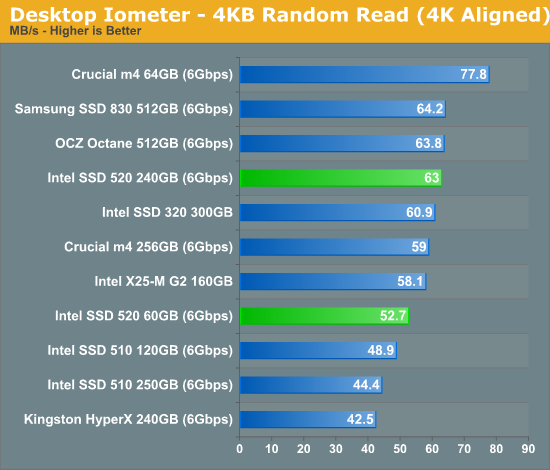
Random read performance seems to have topped out around 60MB/s for most drives and the 520 is no different here.
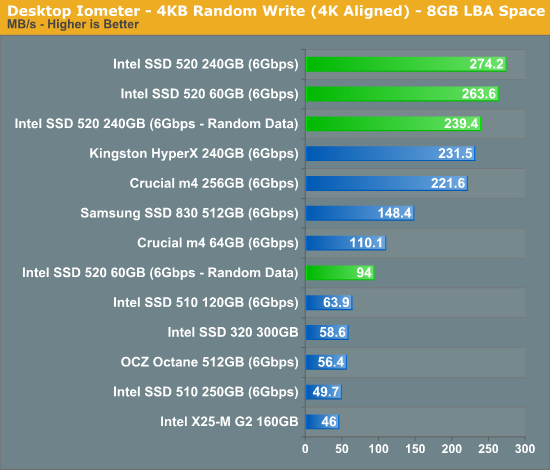
Random write performance, especially with highly compressible data sets the 520 performs beautifully - even outpacing the SF-2281 based Kingston HyperX.
Many of you have asked for random write performance at higher queue depths. What I have below is our 4KB random write test performed at a queue depth of 32 instead of 3. While the vast majority of desktop usage models experience queue depths of 0 - 5, higher depths are possible in heavy I/O (and multi-user) workloads:
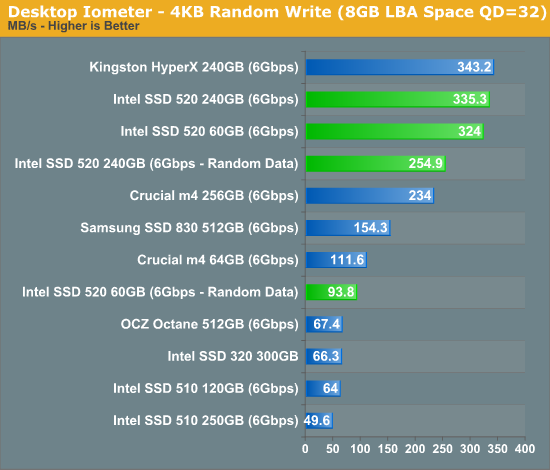
At higher queue depths the HyperX catches up to and surpassed the 520, perhaps indicating that Intel has done some work to optimize low queue depth performance on the 520 (likely what most end users will encounter).
Sequential Read/Write Speed
To measure sequential performance I ran a 1 minute long 128KB sequential test over the entire span of the drive at a queue depth of 1. The results reported are in average MB/s over the entire test length.
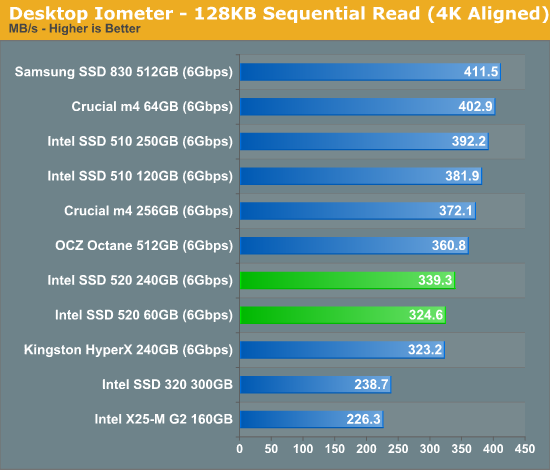
Sequential read performance is actually a bit lower than Intel's 510, but still higher than a standard SF-2281 drive.
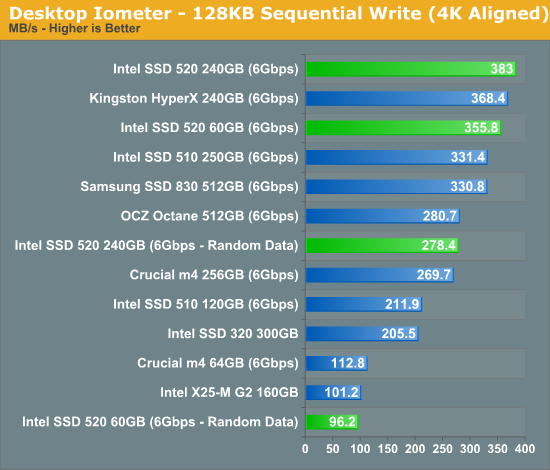
It's important to note just how close the 520's peak random write performance is to its sequential write performance. A big part of this is obviously that the SF-2281 is throwing away a lot of the data it has to write, but even if we compare incompressible 4KB random write to highly compressible 128KB sequential write we see a good ratio. The closer those two values are the more optimal the controller/firmware design is as, in theory, smaller random writes should be grouped to effectively become large sequential writes from the perspective of the NAND.










138 Comments
View All Comments
eman17j - Wednesday, February 8, 2012 - link
Are you trying to say that Amd's cpus are unreliable? I have one and I have no problems at all with it. I dont have crashes or freezes.bji - Wednesday, February 8, 2012 - link
He's a beginner. He doesn't know what he's talking about.eman17j - Wednesday, February 8, 2012 - link
Wrong because the business buys the drive at an higher price then raises the price on their product or service and passes the cost of the drive to the consumer so the consumer ends up paying for the price premium anywaysgamoniac - Monday, February 6, 2012 - link
Is playing game part of Brian's job description?Brian Klug - Monday, February 6, 2012 - link
Heheh, I guess you could say that for once, yes, playing BF3 was part of the job! :)-Brian
Oberst - Monday, February 6, 2012 - link
Seems like there is the first customer with the bsod bug in the intel forum. It seems like the reliability is no better than at all the other SF drives and it's just a matter of (bad) luck.http://communities.intel.com/message/149389#149389
Makaveli - Monday, February 6, 2012 - link
That tool installed his brand new Intel 520 drive in IDE mode?NitroWare - Wednesday, February 8, 2012 - link
You would be surprised how many laptop owners (and even desktop owners) are unaware that they should use AHCI mode. I can guarantee that there are millions of boards out there with modern HDD or SSD in non optimal mode.Another large tech site interviewed several mobo vendors about Z68 and most sad it was supposed to ship with RAID mode as default due to the SRT feature., the reality is much different.
2010 1st gen core i5 thinkpad has problems with third party SSDs which some users claim IDE mode is the only way they get their 'cheap' SSD working
There is a mentality that if a user knows how to physically install a drive then they do not need to do anything else. Then there is the old drivers issues, yeah whatever the motherboard came with at best.
That is something the chipset vendors need to work on. Some motherboards put up a warning if you try to turn AHCI off with an auto counter to re-enable it.
It is definitely possible that a BIOS can detect a SSD and at least put up a text message saying what the recommend setting is. It is hard to ignore such messages.
mustardman29 - Monday, February 6, 2012 - link
I was trying to tell the OCZ support guys ever since their latest firmware that the BSOD is still there. It happens a lot less but it's still there.They were trying to tell me it was something wrong with my system and that I should re-install windows. That the kind of thing I would expect to hear from a 1-800 number that goes to someone in India reading a script. Not from a drive manufacturer.
I'll never buy another OCZ drive. Not because of the problem but because of the way they are dealing with it. Pretending it's does not exist and telling people to re-install windows.
And yes, Sandforce deserves part of the blame for pretending there was no problem for a long time despite many people saying otherwise.
However, I would not hesitate to buy this intel drive. They obviously found the problem and fixed it with their own firmware. Something the controller manufacturer seems incapable of doing.
ckryan - Monday, February 6, 2012 - link
You're not crazy. SF2281s still have stability issues, and the TRIM related BSODs are still happening too. Most people won't ever have problems with a 2281, but many did and still live with the occasional problem. The last round of FW did indeed fix many problems (it solved mine), but others still suffer. I stopped using the drives just because I have quite a few I play with, but you can still get a 2281 to flop on TRIM every once in a while.I'm sure Intel really put the screws to Cherryville's FW, but I think some of the issues with 2281 and their ilk are still mysteries to the SF partners, and possibly even LSI/SF and Intel (the expect fewer problems?).
Here's hoping the next gen of the SF is bulletproof.